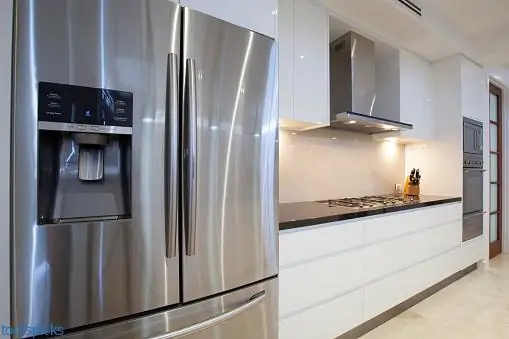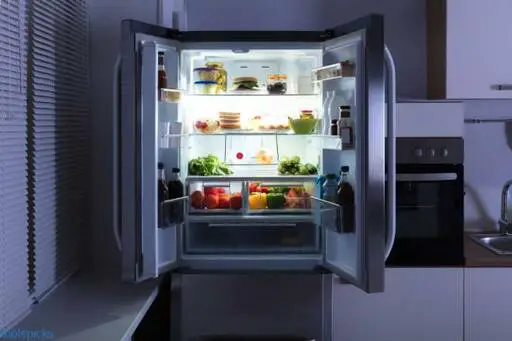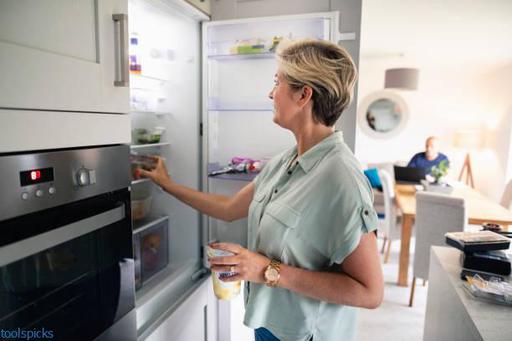If you are experiencing the Samsung refrigerator flashing 33 E code, it can be a little bit confusing as to what is going on. This article will help to explain what this code means and how to go about fixing it. Keep in mind that if you are not comfortable with doing repairs on your own, you should always consult with a professional!
Samsung Refrigerator Flashing 33 E
The Samsung refrigerator 33 E error code is usually caused by a dirty evaporator coil. The evaporator coil is responsible for removing heat from the fridge, so if it is dirty it will not be able to work properly. To clean the evaporator coil, you will need to:
- Unplug your fridge from the power outlet.
- Remove the food and items from your fridge.
- Locate the evaporator coil, which is usually located behind the kick plate or in the back of the fridge.
- Clean the evaporator coil with a vacuum cleaner attachment or a brush. Be sure to get all of the dirt and grime off of the coil!
- Once the coil is clean, plug your fridge back in and turn it on. The error code should be gone and your fridge should be working properly again.
If you are still having trouble with your fridge, or if the error code comes back after cleaning the evaporator coil, it is best to consult with a professional. They will be able to diagnose the problem and help you get your fridge working again in no time!
Samsung Self Diagnostic Test
If you want to run a self-diagnostic test on your Samsung refrigerator, you can do so by following these steps:
- Unplug your fridge from the power outlet.
- Press and hold the POWER COOL and POWER FREEZE buttons at the same time for 3 seconds.
- Release the buttons and then press them again for 3 seconds.
- Release the buttons and then press them again for 3 seconds.
- The display should now show the current error code. If it does not, try pressing the buttons again.
- Once the error code is displayed, refer to the chart below to find out what it means and how to fix it.
Here are some Samsung refrigerator self-diagnostic test error codes are as follows:
1E: indicates a problem with the evaporator fan. This can be caused by a dirty evaporator coil, a damaged evaporator fan, or a problem with the fridge’s power supply. To fix this, you will need to clean the evaporator coil, check the evaporator fan for damage, and/or check the fridge’s power supply.
21: indicates a problem with the condenser fan. This can be caused by a dirty condenser coil, a damaged condenser fan, or a problem with the fridge’s power supply. To fix this, you will need to clean the condenser coil, check the condenser fan for damage, and/or check the fridge’s power supply.
22: indicates a problem with the compressor. This can be caused by a faulty compressor, a problem with the fridge’s power supply, or a problem with the fridge’s cooling system. To fix this, you will need to check the compressor for damage, check the fridge’s power supply, and/or have the fridge’s cooling system checked by a professional.
23: indicates that the refrigerator is not cooling properly. This can be caused by a dirty condenser coil, a blocked airflow, or a problem with the fridge’s thermostat. To fix this, you will need to clean the condenser coil, check for blockages in the airflow, and/or have the fridge’s thermostat checked by a professional.
24: indicates that the freezer is not cooling properly. This can be caused by a dirty evaporator coil, a blocked airflow, or a problem with the fridge’s thermostat. To fix this, you will need to clean the evaporator coil, check for blockages in the airflow, and/or have the fridge’s thermostat checked by a professional.
25: indicates that both the refrigerator and freezer are not cooling properly. This can be caused by a dirty condenser coil, a dirty evaporator coil, a blocked airflow, or a problem with the fridge’s thermostat. To fix this, you will need to clean both the condenser coil and evaporator coil, check for blockages in the airflow, and/or have the fridge’s thermostat checked by a professional.
31: indicates a problem with the fridge’s water filter. This can be caused by a clogged water filter, a problem with the water supply, or a problem with the fridge’s water filter housing. To fix this, you will need to replace the water filter, check the water supply, and/or have the fridge’s water filter housing checked by a professional.
32: indicates that the fridge is not dispensing water. This can be caused by a frozen water line, a clogged water filter, or a problem with the fridge’s water dispenser assembly. To fix this, you will need to thaw the frozen water line, replace the water filter, and/or have the fridge’s water dispenser assembly checked by a professional.
Performing a self-diagnostic test on your refrigerator is a great way to keep it running smoothly and prevent expensive repairs down the road. So be sure to add it to your regular maintenance routine.
Basic Tips On Maintaining Your Refrigerator
Your fridge is one of the most important appliances in your home, so it’s important to keep it running smoothly. Here are a few tips on how to maintain your fridge:
1. Clean the interior and exterior of your fridge regularly. Use a mild soap and water solution to clean the inside, and a damp cloth for the outside.
2. Check the door seal regularly to make sure it’s clean and free of debris. A dirty or damaged door seal can cause your fridge to work harder, which will use more energy and increase your utility bills.
3. Make sure the coils on the back of your fridge are clean and dust-free. Dirty coils can cause your fridge to overwork and wear out prematurely.
4. Keep your refrigerator’s environment clean and clutter-free. If your fridge has a frost-free cabinet and you close it with the door, be sure to leave some space between them. This will ensure proper ventilation and prevent your fridge from working harder than necessary.
Conclusion
In conclusion, it is very important to maintain your refrigerator properly to keep it running smoothly and avoid error codes such as 33 E. Be sure to clean the interior and exterior regularly, check the door seal for damage or debris, and keep the coils dust-free. Additionally, make sure your fridge has proper ventilation by leaving some space between the fridge and any close objects. By following these simple tips, you can extend the life of your fridge and prevent expensive repairs down the road.



